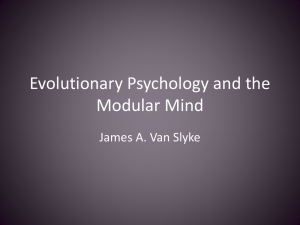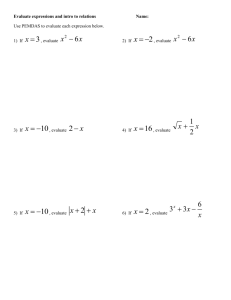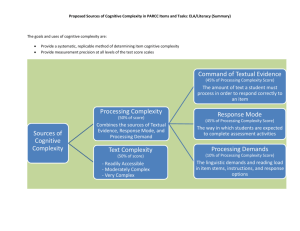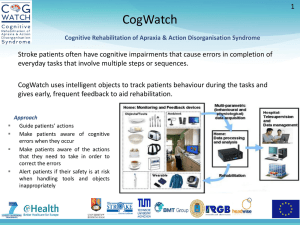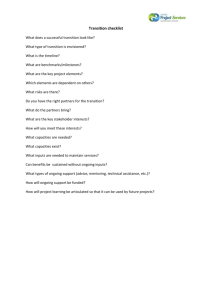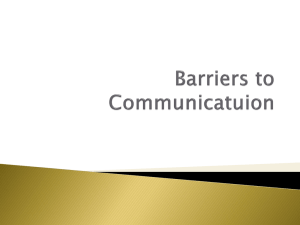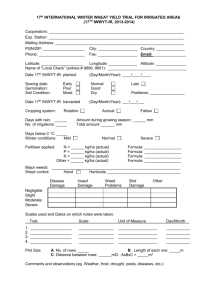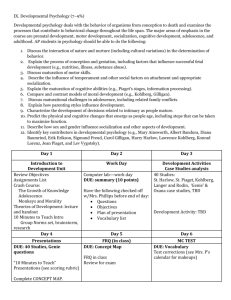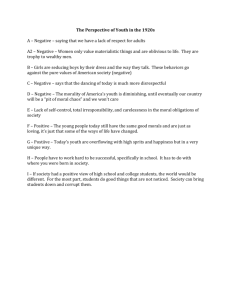Prof. Noam Chomsky´s speech at at the honorary doctorate ceremony
advertisement
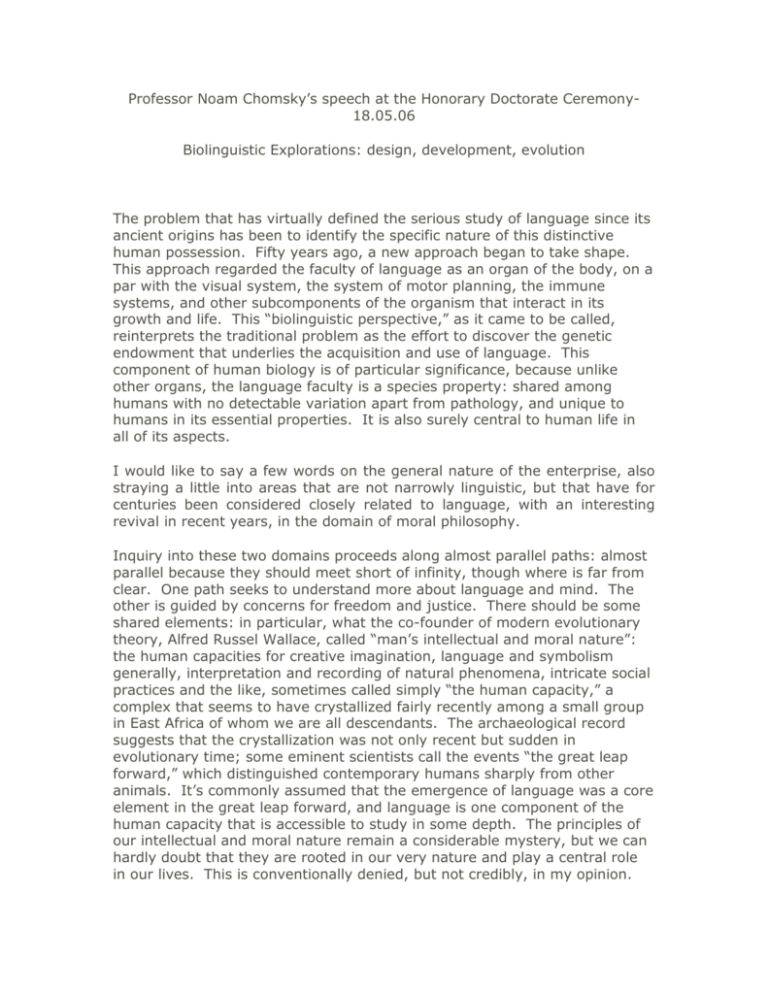
Professor Noam Chomsky’s speech at the Honorary Doctorate Ceremony18.05.06 Biolinguistic Explorations: design, development, evolution The problem that has virtually defined the serious study of language since its ancient origins has been to identify the specific nature of this distinctive human possession. Fifty years ago, a new approach began to take shape. This approach regarded the faculty of language as an organ of the body, on a par with the visual system, the system of motor planning, the immune systems, and other subcomponents of the organism that interact in its growth and life. This “biolinguistic perspective,” as it came to be called, reinterprets the traditional problem as the effort to discover the genetic endowment that underlies the acquisition and use of language. This component of human biology is of particular significance, because unlike other organs, the language faculty is a species property: shared among humans with no detectable variation apart from pathology, and unique to humans in its essential properties. It is also surely central to human life in all of its aspects. I would like to say a few words on the general nature of the enterprise, also straying a little into areas that are not narrowly linguistic, but that have for centuries been considered closely related to language, with an interesting revival in recent years, in the domain of moral philosophy. Inquiry into these two domains proceeds along almost parallel paths: almost parallel because they should meet short of infinity, though where is far from clear. One path seeks to understand more about language and mind. The other is guided by concerns for freedom and justice. There should be some shared elements: in particular, what the co-founder of modern evolutionary theory, Alfred Russel Wallace, called “man’s intellectual and moral nature”: the human capacities for creative imagination, language and symbolism generally, interpretation and recording of natural phenomena, intricate social practices and the like, sometimes called simply “the human capacity,” a complex that seems to have crystallized fairly recently among a small group in East Africa of whom we are all descendants. The archaeological record suggests that the crystallization was not only recent but sudden in evolutionary time; some eminent scientists call the events “the great leap forward,” which distinguished contemporary humans sharply from other animals. It’s commonly assumed that the emergence of language was a core element in the great leap forward, and language is one component of the human capacity that is accessible to study in some depth. The principles of our intellectual and moral nature remain a considerable mystery, but we can hardly doubt that they are rooted in our very nature and play a central role in our lives. This is conventionally denied, but not credibly, in my opinion. Puzzlement about the human capacity goes back to the origins of reflective thought in every culture we know much about. In the West, there was another kind of “great leap forward” in the 17th century, which set the stage for modern science, and also included a cognitive revolution that is a precursor of what is commonly called “the cognitive revolution” of the 1950s, which rediscovered themes that had been developed in thoughtful and instructive ways from which we still have a lot to learn. One theme, developed by the physician/philosopher Juan Huarte in the16th century, is that the essential property of human intelligence is the capacity of the human mind to “engender within itself, by its own power, the principles on which knowledge rests.” Recognition that the capacity to gain understanding relies on fixed principles of the mind is as old as Plato, who could suggest only that the principles are remembered from an earlier life. The 17th century cognitive revolution sought to purge Plato’s theory of “the error of reminiscence,” as Leibniz put it, which means attributing to the mind itself an invariant innate structure. Today we try to reformulate that idea in terms of some genetic endowment, which enables us to construct human experience from chaotic stimuli (different from the experience constructed by other animals) and to rely on internal principles to develop our conception of the world in which we live, including language, moral codes, and a great deal more. For Cartesian scientists, as for Huarte before them, the fundamental nature of human intelligence was a creative capacity, the basic distinction between humans and machines. Much like contemporary scientists, the Cartesians were greatly intrigued by the capacities of machines, not computers but the remarkable artifacts constructed by skilled artisans. And they sought to show that the world was a machine, constructed by the most skilled artisan of them all. That was the so-called “mechanical philosophy,” in our terms “mechanical science.” Descartes’s conclusion was that machines included the inorganic world, animals, and in fact virtually everything about humans as well, apart from the creative capacity, which for him and his followers was exhibited most clearly in the use of language to express thought: the capacity of every person, but no beast or machine, to construct linguistic expressions without bound, undetermined by external stimuli or internal physical states, appropriate to circumstances but not caused by them – a fundamental distinction -- and eliciting thoughts in others that they could have expressed the same way. Use of language and other human action is “incited and inclined” by external and internal factors, but not “compelled,” in their terms – conclusions that we have no reason to doubt. Since the mechanical philosophy could not extend this far, they proposed new principles – in the metaphysics of the day, a new substance, res cogitans, a thinking substance alongside of material substance. The move was normal science. The next task was to find its properties and to try to unify the two branches of science. That task was undertaken, but soon terminated, for entirely unexpected reasons. Cartesian psychologists developed experimental tests to determine whether another creature has these creative capacities, and concluded that if it passes the strictest tests we can devise, it would only be reasonable to conclude that it has a mind like ours; again, normal science. The 17th century concerns also led to investigation of the nature of concepts, some of them called “common notions” or “innate ideas,” which are part of our nature, developed or refined through experience. They also contributed to investigation of the principles by which linguistic expressions are constructed, a research program that came to be called philosophical grammar, meaning what we would call scientific grammar. David Hume recognized that knowledge and belief are grounded in a “species of natural instincts,” part of our inherent mental nature. He recognized that something similar must be true in the domain of moral judgment as well. The reason is that our moral judgments are unbounded in scope and that we constantly apply them in systematic ways to new circumstances. Hence they too must be founded on general principles that are part of our nature though beyond our “original instincts,” the instincts shared with animals. That should lead directly to efforts to develop something like a grammar of moral judgment. That project was undertaken by the leading American moral and political philosopher of the late 20th century, John Rawls, who was using linguistic models of generative grammar that were being developed as he was writing his classic Theory of Justice in the 1960s. In the last few years that has become a lively field of theoretical and empirical inquiry as well. The mechanical philosophy, the underpinnings of 17th century science, was refuted by Isaac Newton. Newton demonstrated, to the consternation of scientists of the day including Newton himself, that there is no coherent notion of machine (or body, physical, material, etc.) that holds for the natural world without appeal to occult forces of the kind that science since Galileo had been trying to abolish. We have no insight into nature beyond the best theories of various aspects of the world that we can devise, always looking forward to deeper explanation and eventual unification, though in unpredictable and often quite surprising ways. The mind-body problem became unformulable, because the notion of body disappeared. It followed that “mental aspects of the world” should be considered on a par with all others: chemical, optical, electrical, and so on. Putting aside the theological framework, there was little alternative to the speculation by John Locke that God might have chosen to “superadd to matter a faculty of thinking” just as he “annexed effects to motion which we can in no way conceive motion able to produce” -- notably the property of attraction at a distance, a revival of occult properties, many leading scientists argued (with Newton's partial agreement, much to his dismay). “Locke’s suggestion,” as it came to be called, was pursued in the years that followed, leading to the conclusion that properties “termed mental” reduce somehow to “the organical structure of the brain,” in the formulation of the famous scientist Joseph Priestley in the late 18th century. However, it all seems to have been forgotten. Today we regularly read from eminent scientists and philosophers about the “astonishing hypothesis” that the mind is the result of the organization of the brain, a “bold hypothesis” and “radically new idea” in philosophy of mind, and so on – in fact, reiterating formulations of centuries ago in virtually the same words. It’s worth noting that the phrase “mind-body problem” has recently come to be used for a very different problem, only loosely related to the traditional one, which was part of normal science. The new version resurrects some observations of Bertrand Russell’s 80 years ago, and recently re-invented. Russell asked us to consider a blind physicist who knows all of physics but doesn’t know something we know: what it’s like to see the color blue. Russell’s conclusion was that the natural sciences seek to discover “the causal skeleton of the world.” Other aspects of the world of experience lie beyond their reach. Recasting Russell’s insight in naturalistic terms, we might say that like all animals, our internal cognitive capacities reflexively provide us with a world of largely shared experience, but being reflective creatures, thanks to emergence of the human capacity, we go on to seek to gain a deeper understanding of the phenomena of experience. These exercises are called myth, or magic, or philosophy, or “science,” in contemporary terminology. If humans are part of the organic world, we expect that our capacities of understanding and explanation have fixed scope and limits, like any other natural object. It could be that these innate capacities do not lead us beyond some understanding of Russell’s causal skeleton of the world, and it is always an open question how much of that can be attained. These could become topics of empirical inquiry into the nature of what we might call “the scienceforming faculty,” another “mental organ.” These are interesting topics, in principle part of normal science. They should not be confused with the traditional mind-body problem, which evaporated after Newton. The cognitive revolution of the 17th century also led to inquiry into the nature of concepts, with important contemporary implications, also insufficiently appreciated. Aristotle had recognized that the objects to which we refer in using language cannot be identified by their material substance. A house, he pointed out, is not merely a collection of bricks and wood, but is defined in part by its function and design: a place for people to live in and store their possessions, and so on. In Aristotle’s terms, a house is a combination of matter and form. Notice that his account is metaphysical: he is defining what a house is, not the word or idea “house.” That approach led to hopeless conundrums. With the cognitive turn of the 17th century these questions were reframed in terms of operations of the mind: what does the word “house” mean, and how do we use it to refer. Pursuing that course we find that for natural language there is no word-object relation, where objects are mindindependent entities. The many conundrums based on the myth of a word- object relation dissolve when viewed from this perspective, which I believe has ample empirical support. One may be misled by the fact that houses are artifacts, so let’s consider simpler cases that were investigated in the 17th-18th century classics. Take “river,” a notion that Thomas Hobbes considered. He suggested that rivers are mentally individuated by origin. But while there is some truth to the observation, it is not really accurate, and it only scratches the surface of our intuitive understanding of the concept. Take the Charles River, which flows near my office. It would remain the very same river under quite extreme changes – among many others, reversing its course, so origin cannot be the defining characteristic. It would still be the Charles River if it were divided into separate streams that converge in some new place, or if any H20 that happens to be in it were replaced by chemicals from an upstream manufacturing plant. On the other hand, under trivial changes it would no longer be a river at all: for example, directing it between fixed boundaries and using it for shipping freight (in which case it is a canal, not a river), or hardening the surface by some almost undetectable physical change, painting a line down the middle, and using to drive to Boston (in which case it is a highway). And on to further intricacies as we can easily determine. Much the same holds of even the simplest concepts. Exploring them confirms the conclusion that the world of experience and interpretation is constructed by our rich cognitive powers, relying on gestalt properties, causal relations, and other mental notions explored by 17th century British philosophers and their successors. Summarizing many years of discussion of such topics, David Hume concluded that “the identity we ascribe” to minds, vegetables, animal bodies and other entities is “only a fictitious one” established by the imagination, not a “peculiar nature belonging to this form.” His conclusion is I think correct. There are no mind-independent objects, which could in principle be identified by a physicist, related to names or more complex referring expressions. As Hume and others recognized, we do not think or talk about the world in terms of mind-independent objects; rather, we focus attention on intricate aspects of the world by resort to our cognitive powers. Accordingly, for natural language and thought there is no notion of reference in the sense of the modern philosophical tradition, developed in the work of Frege, Peirce, and their successors, including contemporary theorists of reference. These technical concepts are fine for the purpose for which they were originally invented: formal systems where the symbols, objects, and relations are stipulated. Arguably they also provide a norm for science: its goal is to construct systems in which terms really do pick out an identifiable mindindependent element of the world, like “neutron,” or “noun phrase.” But human language and thought do not work that way. If that is true – and the evidence seems overwhelming – then natural language diverges sharply in these elementary respects from animal communication, which has been held to rely on a one-one relation between mind/brain processes and “an aspect of the environment to which these processes adapt the animal's behavior” (quoting a leading specialist on animal communication). If so, then one basic problem facing the study of evolution of human language and thought is to account for the emergence of these universal and innate human properties, not a trivial matter, as we quickly discover when we take words and ideas seriously. When we move beyond the simplest elements of language, problems of this kind escalate very sharply. There is no time to discuss concrete examples, but what we find, quite generally, is that the surface forms that are produced and heard do not yield their interpretations in any straightforward way. The general conclusion is that even the simplest elements of sound and meaning find their place in the internal computational processes that yield the expressions, but cannot in general be detected in the physical signal. For that reason, the language acquired must have the basic properties of an explanatory theory. And as well understood, theory construction is impossible unless the choice of admissible hypotheses is limited by some pre-existing scheme – for language, one that is genetically fixed. These are design properties that must be dealt with by an account of the growth of language in the individual – language acquisition – and its evolution in the species, alongside of the elementary semantic properties of the simplest words. The prevailing conceptions posed a kind of paradox. Considerations of acquisition entailed that the pre-existing scheme must be highly restricted so as to limit admissible hypotheses. But that runs counter to the apparent limitless variety of attainable languages. About 25 years ago, efforts to overcome the paradox converged in an approach that seemed to offer a kind of conceptual breakthrough. This approach proposed a sharp distinction between process of acquisition and the format of the internal theory of language. The basic idea is that the genetic endowment provides a fixed system of principles that interact in the generation of the expressions of a language, and a fixed set of parameters that are assigned a value by exposure to external data. A language is determined by setting the values and selecting lexical items from a fixed and highly structured store, with properties of the kind I’ve mentioned. The promissory note is to be paid by showing that the parameters are simple enough so that the values can be set by the data available to children, and that the fixed principles, with parameters set, function automatically to yield the rich variety of expressions for every possible human language, with their specific interpretations. That’s a huge empirical task, of course, but one that has been pursued with considerable success. The approach also removed a crucial conceptual barrier to the study of evolution of language. In earlier approaches, it appeared that the genetically-determined format for language had to be highly articulated, richly structured, and specific to language, sharply restricting admissible hypotheses so as to account for the rapidity and convergence of acquisition. Plainly, the greater the richness and specificity of the format, the harder it will be to account for its evolution. But by divorcing acquisition from the format for language, that conceptual problem is overcome. It may still turn out that the innate mechanisms are rich, highly structured, and specific to language, but that is no longer a conceptual necessity, within the new framework. To determine just how rich and highly structured the genetic endowment is, it is necessary to discover to what extent they reflect the workings of natural law – in the case of a computational system like language, conditions of computational efficiency, in particular. In recent years, evidence has been accumulating that a good deal of what was taken to be specific to language may be explicable in such terms. Meanwhile what some biologists now call the evo-devo revolution was increasingly showing that “the rules controlling embryonic development” interact with other physical conditions “to restrict possible changes of structures and functions” in evolutionary development, providing “architectural constraints” that “limit adaptive scope and channel evolutionary patterns” (quoting prominent evolutionary biologists). By now it seems not unrealistic to suspect that the apparent diversity both of languages and life forms is superficial, and that in fundamental respects they are variations on rather limited themes. The language that each person has mastered generates an infinite array of expressions, which provide the information relevant for thought and action, in particular production and perception of speech. We may say that the internal language has two interfaces: with the system of thought and the sensorimotor system. To be usable, the internal language must satisfy conditions imposed by these interfaces, and it will do so in an optimal way insofar as its properties are determined by natural law, in which case we can provide principled explanations for the properties of human language. The investigation of language design is, I think, tending to support the conclusion that language may indeed approach optimal design with regard to the thought interface, but not the sensorimotor interface. There are also independent reasons to expect that to be true, matters of some significance for inquiry into the nature and origins of language and the human capacity. One reason is that externalization appears to be independent of sensory modality, as has been learned from studies of sign language in recent years. The structural properties of sign and spoken language appear to be remarkably similar. Acquisition follows the same course, and neural localization seems to be similar as well. Children raised in bimodal environments – one parent speaking and the other signing – seem to exhibit no preference, treating the two languages just as if they were exposed to Spanish and English. That tends to reinforce the conclusion that language is optimized for the system of thought, with mode of externalization secondary. More general considerations support the same conclusion. The core principle of language, which appears to be isolated in the biological world, is an operation that forms mind-internal syntactic objects from lexical items, and can reapply to its own output, so that having formed two such objects, it constructs another one in an optimal way. That operation yields infinitely many hierarchically organized expressions, and thus takes us part of the way towards dealing with Descartes’s problem. This operation must have arisen from some rewiring of the brain, presumably not too long before the “great leap forward,” hence very recently in evolutionary time. Such changes take place in an individual, not a group. The individual so endowed would have had many advantages: capacities for complex thought, planning, interpretation, and so on. The capacity would be transmitted to offspring, coming to dominate a small breeding group. At that stage, there would be an advantage to externalization, so the capacity would be linked as a secondary process to the sensorimotor system for externalization and interaction, including the special case of communication. It is not easy to imagine an account of human evolution that does not assume at least this much, in one or another form. And it is not clear how much more is needed. The quest for principled explanation faces daunting tasks. We can formulate the goals with reasonable clarity. With each step towards the goal we gain a clearer grasp of the essential nature of language. It should be kept in mind, however, that any such progress still leaves unresolved problems that have been raised for hundreds of years. Among these is the question how properties “termed mental” relate to “the organical structure of the brain,” in the 18th century formulation, and also the mysterious problems of the creative and coherent ordinary use of language, a central problem of Cartesian science, still scarcely even at the horizons of inquiry.
